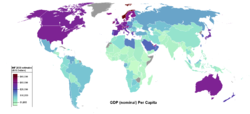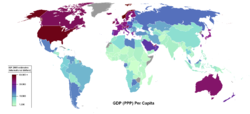Within a country, we usually want to convert nominal GDP to real GDP by netting out the effects of inflation with a price index. This is not perfect because of the problems in measuring prices accurately across time: 1) quality improvements aren’t easily separable from prices, and 2) new products can’t be compared at all. We can’t talk fruitfully about per capitas and well-being until we’re satisfied with how we address this problem.
For international comparisons, the problems are worse, since countries measure their nominal GDP in their own currency.
Most simply, we could just use exchange rate between two countries to put their measures in terms of the currency of one country or the other, and then use a price index to make them real. Here’s some exchange rate adjusted per capita real GDP data and a chloropleth:

The problem with this is that prices differ across countries for the same good (see The Economist’s Big Mac Index for a popular example).
Purchasing Power Parity is the general way of correcting for this problem. The principle is similar to how you would do a real to nominal conversion within a country: you put together a “market basket” and you calculate it’s price in both places. You then weight nominal GDP so that it is higher in place where that basket is cheaper. Here’s some data on PPP-adjusted per capita GDP. In these chloropleths, exchange rate adjusted GDP is shown in the top panel (really, the same chloropleth as above, but from a different source), and PPP adjusted per capita GDP is shown in the bottom panel. Note that, just to confuse students further, it is standard to call exchange rate adjusted GDP “nominal”, even though we already call unadjusted GDP nominal.


People care about per capita GDP. Governments keep score of aggregate GDP. Here’s some data and a chlorpleth: the top panel shows PPP-adjusted aggregate GDP, while the bottom panel shows exchange rate adjusted aggregate GDP.

Neither of these measures are perfect: exchange rate adjustment tends to make countries with higher per capita GDP look better, and PPP adjustment tends to make countries with lower per capita GDP look richer than they are. The reason for both is that people adjust by buying what is locally cheap.
Professionals lean towards using PPP because … well … um … if more work goes into it, it must be better. Thoughtful professional know the true value is somewhere in the middle.
There simply isn’t any doubt that if India and China can hold themselves together, that eventually both will surpass the US in GDP. PPP tends to be used by people who think this will happen sooner rather than later.
The difficulty with this is that PPP reflects locals buying what is cheap locally. But often that is catering to local tastes. As countries become richer, their people’s tastes change, so the process of income convergence doesn’t go as quickly as one might naively expect.
No comments:
Post a Comment